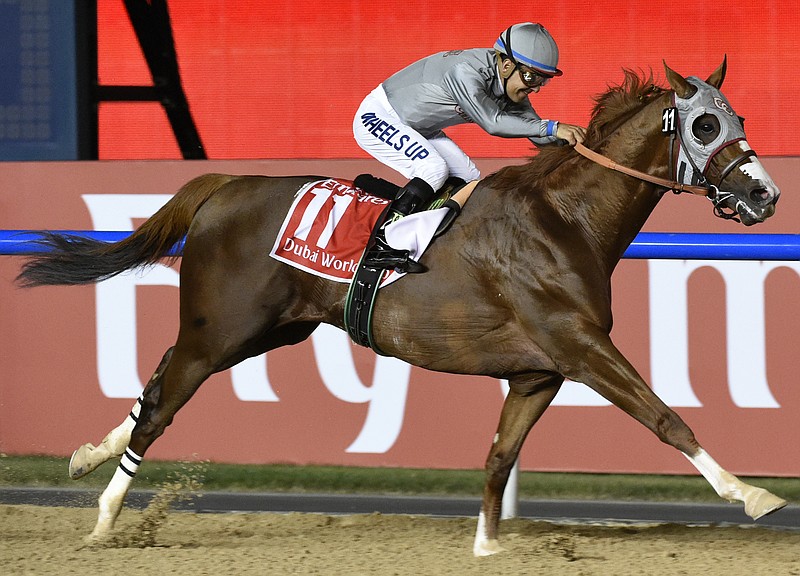What if they ran a horse race and nobody came?
On the face of it, that might seem to be the only way for the public to make a statement that anyone at the Santa Anita race track in Southern California will listen to after the famed track lost its second horse in two days this past weekend and its highly disturbing 29th overall since December.
Naturally, business being business, the track's management has said it will continue to run until its current meet ends on June 23. Because Santa Anita is open only three days a week, that leaves six days of racing unless the California Horse Racing Board can force the track to cancel the rest of the meet, which has been the CHRB's request.
Unfortunately, according to The Associated Press, the racing board doesn't have the authority to suspend a race meet or remove race dates from a current meet without the approval of the track operator or without holding a public meeting that requires 10 days' notice.
Do the math and the meet's final weekend June 21-23 might still be canceled, but this weekend's race card will go on as planned.
"It is our understanding that Santa Anita management, after consultation with certain other industry stakeholders, believes that for a variety of reasons, the future of California racing is best served by continuing to race," the racing board said in a released statement.
But is it not fair to ask if the future of horse racing everywhere is being threatened by the deaths of all these horses at Santa Anita? The Belmont, the third leg of racing's Triple Crown, was held this past Saturday to what seemed like less pre-race fanfare than at any time over the past 50 years.
Much of that surely was due to the oddest Kentucky Derby in recent memory rather than the lack of star power at the Belmont, which was won by 10-to-1 long shot Sir Winston. When it took Derby racing stewards more than 20 minutes to disqualify the first to cross the finish line in the Run for the Roses - Maximum Security - in favor of 51-to-1 long shot Country House, a little more luster was lost from a sport that needed no such controversy, even if almost everyone long associated with thoroughbred racing believed it was the right call.
Then injuries robbed the second leg of the Triple Crown, the Preakness, of both Maximum Security and Country House. Add in a riderless horse after it threw its jockey early in the Preakness and it's easy to see why anyone would think the industry was becoming both riderless and rudderless.
But Santa Anita's apparent strategy to point the finger at everyone and everything except the condition of the track following unusually severe rains has horse folks worried that the messenger is presenting the wrong message by blaming training methods and medication.
"I've lost three horses in 35 years," Kentucky-based trainer Neil Pessin said Monday from the Churchill Downs back side in Louisville. "I can tell you where each one happened, why it happened and how I dealt with it.
"These horses are like our children. We grieve the way you do when you lose a close friend or loved one. It hurts. Sometimes that hurt never goes away. So to act as if we don't put the animal first is wrong. It's 100 percent wrong."
Further addressing the notion that the liberal use of the anti-inflammatory drug Lasix or training methods is the cause of many of the fatalities, Pessin argued, "The vast, vast majority of horses on the track are treated better than 99 percent of the animals on earth and probably better than close to 100 percent of humans. I know I take better care of my horses than I do me, and that goes for most trainers."
Like many horsemen, Pessin believes Santa Anita's abnormally soft track following those massive rains are to blame for many of the deaths that came about in early winter. Due to that soft track, the theory is that Santa Anita - typically one of the firmer in the country - fell victim to uncertain footing for animals thrusting 1,100 pounds or more onto a single narrow ankle.
"Unfortunately, fatalities are part of our sport," Pessin said. "Do we like it? No, we despise it. You do everything you can to prevent them, but one of those deaths this weekend was due to a heart attack. It had nothing to do with training methods. It just happens."
But something tragic has happened at Santa Anita, and with the venerable track set to host the Breeders' Cup world championships - thorougbred racing's Super Bowl - Nov. 1-2, one can't help but wonder if a late change in venue wouldn't at least dull criticism for the industry rather than bringing it into the sharpest focus possible.
"We're not out there killing horses, but that's what people think we're doing," Pessin said. "We need to start letting the public see how much owners and trainers love their horses and care about their well-being, because if people are allowed to keep thinking we don't care, it could have a profound long-term effect on horse racing."
If it does, let's at least hope the blame is largely placed on tracks such as Santa Anita rather than trainers such as Pessin.
Contact Mark Wiedmer at mwiedmer@timesfreepress.com
